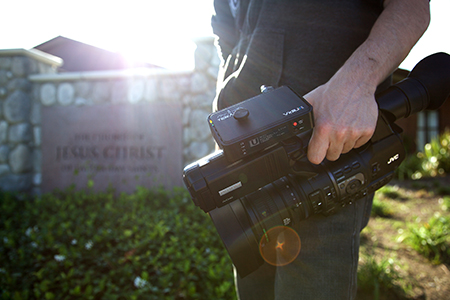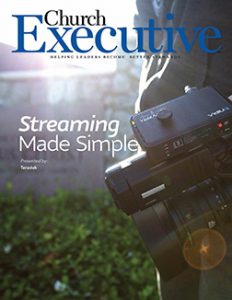
By Andrew Ng
![]() “Streaming” — the constant flow of digital media across the Web — has become a key form of communication to audiences and viewers around the world. It’s a rapidly growing field which Teradek aims to democratize — not only for professionals, but also for everyday people … especially church leaders. Here’s why streaming makes so much sense in houses of worship.
“Streaming” — the constant flow of digital media across the Web — has become a key form of communication to audiences and viewers around the world. It’s a rapidly growing field which Teradek aims to democratize — not only for professionals, but also for everyday people … especially church leaders. Here’s why streaming makes so much sense in houses of worship.
#1: It’s cost-effective.
Perhaps the best reason to consider streaming is stewardship — namely, its low-cost barrier to entry. Because this technology has stemmed from the television, music and sports industries, a vast infrastructure of economical solutions already exists.
Whereas traditional broadcasting in houses of worship usually requires a large budget for equipment, the production team and more, streaming runs on cost-effective platforms and technologies. Many of the companies working to make streaming more affordable (Teradek included) have roots in traditional broadcast and high-end production. As such, quality and reliability of the technology is at the forefront, as is a focus on affordability and — hugely important — simplicity.
#2: It’s not as complicated as it sounds … and you’re not going it alone.
 For pastors who are unfamiliar with live streaming, the best thing they can do is surround themselves with people and companies who are. Fortunately, many companies, like Teradek, are invested in making live streaming more affordable and accessible.
For pastors who are unfamiliar with live streaming, the best thing they can do is surround themselves with people and companies who are. Fortunately, many companies, like Teradek, are invested in making live streaming more affordable and accessible.
For comparison’s sake, let’s look at the three main technology components required for traditional broadcasting: transmission connectivity (usually satellite connection), capturing tools (cameras and additional content), and transmission tools — the hardware and products that actually send the capturing tools to the final destination. Each of these key components can be scaled to suit a live streaming format.
Transmission connectivity. Connectivity essentially determines the stability and quality of any broadcast or live stream. In the traditional broadcast world, connectivity is typically achieved via satellite connections. So, when you see a local news van driving around with a large dish antenna at the top of the vehicle, they’re using a satellite to make that connection. This is a very stable — yet considerably expensive — means of transmitting data and video.
For the everyday live streamer (including a house of worship), connectivity can be achieved using a business-grade and even consumer-level internet connection from a local service provider. And, because internet is already being provided to businesses and residential locations, it’s a technology that already has a reliable infrastructure and support.

Recently, cellular connectivity has hit the radar, as well. Amazingly, the same connection that a personal cell phones uses is now able to provide the amount of bandwidth needed for live streaming. These speeds are most commonly identified by carriers advertising as LTE, 4G and 3G, to name a few. Cellular connectivity is popular because it’s basically available anywhere you can make a phone call. So, for portability and remote live streaming (retreats or mission trips, for example), this is an excellent solution that Teradek supports.
Capturing tools. Cameras come in all shapes and sizes. Features are virtually endless — as are price points. In the past 10 years, however, costs for great cameras have really come down, making them much more accessible.
All Teradek’s products have been created with this availability in mind. Regardless of the Teradek streaming device you choose, it’s designed to work with virtually all cameras with video output, of which the two most popular connections are HDMI and HD-SDI.
Transmission tools. Whether your church is doing traditional broadcasting or live streaming, the workflows call for an encoder. This piece of technology takes the audio and video and uses the transmission connectivity to produce a product for an audience. Encoders receive the full-quality video signal from cameras and, in real-time, convert the video to a format that’s able to send over the transmission connectivity.
Like most of the other key elements in the workflow, these devices are specialized and produced for professionals in demanding environments. Providing a solution to this component in the workflow is Teradek’s specialty. The quality of real-time conversion and encoding comes from the highest level of traditional broadcasting; it’s just packaged in products that are more affordable — and easier to use — for everyday organizations.
#3: Its reach is virtually limitless — and immediate.
Right now, the Internet is able to reach virtually anybody, anywhere. The same can’t be said of traditional broadcasts. This far-reaching immediacy is one of the best reasons for church leaders to consider streaming.
Whether it’s communicating to church members who can’t make it to an event, or spreading the Word to audiences around the world, streaming is an incredibly powerful vehicle for communication, expansion and expression.
Many houses of worship that are already streaming consider community a top priority. For them, the ability to constantly share and document events has proven essential in developing and maintaining strong communities.
Now that streaming has become more widely available — and at lower costs — church leaders can harness this technology and free themselves up to focus on what they truly love: ministry.
Andrew Ng is Marketing Manager at Teradek in Irvine, CA.


